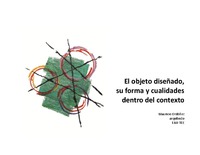Mostrar el registro sencillo del ítem
El objeto diseñado, su forma y cualidades dentro del contexto
| dc.contributor.author | Ordóñez-Chacón, Mauricio-José | |
| dc.date.accessioned | 2021-03-16T19:04:44Z | |
| dc.date.available | 2021-03-16T19:04:44Z | |
| dc.date.issued | 2016 | |
| dc.identifier.uri | https://hdl.handle.net/2238/12385 | |
| dc.description | Instituto Tecnológico de Costa Rica. Escuela de Arquitectura y Urbanismo, 2016. | es |
| dc.description.abstract | Este ensayo investigativo con finalidad didáctica propone una taxonomía conceptual sistémica apta para analizar los objetos diseñados en su relación con el contexto, ya sean arquitectónicos, urbanos u otros objetos industriales y artesanales. Las categorías analíticas utilizadas tienen diversas fuentes: Se considera al objeto funcional artificial una fusión de materia y espacio cuya forma define su esencia categorial, en su fundamento aristotélico. La forma del objeto se ajusta a su contexto, resultado de los entornos humanos, construido y natural interactuando. Sus cualidades de utilidad, estabilidad, significados y costo económico y ambiental son una actualización de las tradicionales categorías vitruvianas, que responden a las necesidades y deseos humanos. La sostenibilidad como una supra-cualidad. Objeto-cualidades-contexto. En arquitectura, el objeto se vuelve espacio arquitectónico al ser percibido y usado en su contexto. Todo esto como una estructura sistémica, en el sentido estructuralista del término: física y formal en el objeto, y cualitativa en su relación con el contexto. Se evidencia el mal enfoque de la triada analítica forma-función-estructura aplicada al diseño. Aparte de aclarar conceptos, se espera que sea una epistemología instrumental, es decir, no solo una teoría sustantiva para la enseñanza y el aprendizaje, sino también de utilidad práctica para el diseño y evaluación sistemática de proyectos. | es |
| dc.description.abstract | “The designed object, its form and qualities, within the context”. This investigative essay with didactic purposes proposes a systemic conceptual taxonomy suitable for analyzing the designed objects in their relationship with the context, whether they are architectural, urban or other industrial and artisan objects. The analytical categories used have different sources: The artificial functional object is considered a fusion of matter and space whose shape defines its categorical essence, in its Aristotelian foundation. The shape of the object adjusts to its context, the result of human, built and natural environments interacting. Its qualities of utility, stability, meanings and economic and environmental cost are an update of the traditional Vitruvian categories, which respond to human needs and desires. Sustainability as a supra-quality. Object-qualities context. In architecture, the object becomes architectural space by being perceived and used in its context. All this as a systemic structure, in the structuralist sense of the term: physical and formal in the object, and qualitative in its relationship with the context. The poor approach of the form-function-structure analytical triad applied to design is evident. Apart from clarifying concepts, it is expected to be an instrumental epistemology, that is, not only a substantive theory for teaching and learning, but also of practical utility for the design and systematic evaluation of projects. | es |
| dc.description.sponsorship | Escuela de Arquitectura y Urbanismo. | es |
| dc.language.iso | spa | es |
| dc.publisher | Instituto Tecnológico de Costa Rica. | es |
| dc.rights | acceso abierto | es |
| dc.subject | Forma geométrica | es |
| dc.subject | Forma topológica | es |
| dc.subject | Estructura sistémica | es |
| dc.subject | Semiótica y arquitectura | es |
| dc.subject | Teoría de la arquitectura | es |
| dc.subject | Simbolismo en arquitectura | es |
| dc.subject | Geometric shape | es |
| dc.subject | Topological Form | es |
| dc.subject | System structure | es |
| dc.subject | Semiotics and architecture | es |
| dc.subject | Architecture theory | es |
| dc.subject | Symbolism in architecture | es |
| dc.title | El objeto diseñado, su forma y cualidades dentro del contexto | es |
| dc.type | informe | es |
Ficheros en el ítem
Este ítem aparece en la(s) siguiente(s) colección(ones)
-
Docencia [3]


